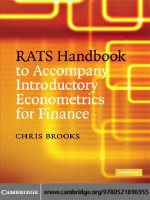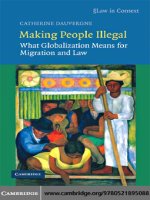cambridge university press party competition between unequals strategies and electoral fortunes in western europe jun 2008 kho tài liệu bách khoa
Bạn đang xem bản rút gọn của tài liệu. Xem và tải ngay bản đầy đủ của tài liệu tại đây (2.11 MB, 338 trang )
This page intentionally left blank
Party Competition between Unequals
Why do some political parties flourish while others flounder? In this book, Bonnie M.
Meguid examines variation in the electoral trajectories of the new set of single-issue
parties: green, radical right, and ethnoterritorial parties. Instead of being dictated
by electoral institutions or the socio-economic climate, as the dominant theories
contend, the fortunes of these niche parties, she argues, are shaped by the strategic
responses of mainstream parties. She advances a new theory of party competition
in which mainstream parties facing unequal competitors have access to a wider and
more effective set of strategies than posited by standard spatial models. Combining statistical analyses with in-depth case studies from Western Europe, the book
explores how and why established parties undermine niche parties or turn them
into weapons against their mainstream party opponents. This study of competition
between unequals thus provides broader insights into the nature and outcome of
competition between political equals.
Bonnie M. Meguid is an assistant professor of political science at the University of
Rochester. Her research on party competition has been published in The American
Political Science Review. Her research has been funded by grants from the National
Science Foundation and the Krupp Foundation, and her doctoral dissertation was
awarded the Samuel H. Beer Prize for Best PhD Dissertation on British Politics by
the British Politics Group.
Cambridge Studies in Comparative Politics
General Editor
Margaret Levi University of Washington, Seattle
Assistant General Editor
Stephen Hanson University of Washington, Seattle
Associate Editors
Robert H. Bates Harvard University
Helen Milner Princeton University
Frances Rosenbluth Yale University
Susan Stokes Yale University
Sidney Tarrow Cornell University
Kathleen Thelen Northwestern University
Erik Wibbels University of Washington, Seattle
Other Books in the Series
Lisa Baldez, Why Women Protest: Women’s Movements in Chile
Stefano Bartolini, The Political Mobilization of the European Left, 1860–1980: The
Class Cleavage
Mark Beissinger, Nationalist Mobilization and the Collapse of the Soviet State
Nancy Bermeo, ed., Unemployment in the New Europe
Carles Boix, Democracy and Redistribution
Carles Boix, Political Parties, Growth, and Equality: Conservative and Social Democratic Economic Strategies in the World Economy
Catherine Boone, Merchant Capital and the Roots of State Power in Senegal, 1930–
1985
Catherine Boone, Political Topographies of the African State: Territorial Authority and
Institutional Change
Michael Bratton and Nicolas van de Walle, Democratic Experiments in Africa:
Regime Transitions in Comparative Perspective
Michael Bratton, Robert Mattes, and E. Gyimah-Boadi, Public Opinion, Democracy, and Market Reform in Africa
Valerie Bunce, Leaving Socialism and Leaving the State: The End of Yugoslavia, the
Soviet Union, and Czechoslovakia
Daniele Caramani, The Nationalization of Politics: The Formation of National Electorates and Party Systems in Europe
Continued after the Index
To Michael and in Memory of my Grandmothers
Party Competition between Unequals
STRATEGIES AND
ELECTORAL FORTUNES
IN WESTERN EUROPE
BONNIE M. MEGUID
University of Rochester
CAMBRIDGE UNIVERSITY PRESS
Cambridge, New York, Melbourne, Madrid, Cape Town, Singapore, São Paulo
Cambridge University Press
The Edinburgh Building, Cambridge CB2 8RU, UK
Published in the United States of America by Cambridge University Press, New York
www.cambridge.org
Information on this title: www.cambridge.org/9780521887656
© Bonnie M. Meguid 2008
This publication is in copyright. Subject to statutory exception and to the provision of
relevant collective licensing agreements, no reproduction of any part may take place
without the written permission of Cambridge University Press.
First published in print format 2008
ISBN-13 978-0-511-40880-9
eBook (EBL)
ISBN-13
hardback
978-0-521-88765-6
Cambridge University Press has no responsibility for the persistence or accuracy of urls
for external or third-party internet websites referred to in this publication, and does not
guarantee that any content on such websites is, or will remain, accurate or appropriate.
Contents
List of Tables and Figures
page viii
List of Abbreviations and Acronyms
xi
Acknowledgments
xv
1
THE NICHE PARTY PHENOMENON
2
POSITION, SALIENCE, AND OWNERSHIP: A
STRATEGIC THEORY OF NICHE PARTY SUCCESS
22
AN ANALYSIS OF NICHE PARTY FORTUNES IN
WESTERN EUROPE
41
4
A THEORY OF STRATEGIC CHOICE
91
5
STEALING THE ENVIRONMENTAL TITLE: BRITISH
MAINSTREAM PARTY STRATEGIES AND THE
CONTAINMENT OF THE GREEN PARTY
110
“THE ENEMY OF MY ENEMY IS MY FRIEND”:
FRENCH MAINSTREAM PARTY STRATEGIES AND
THE SUCCESS OF THE FRENCH FRONT NATIONAL
143
AN UNEQUAL BATTLE OF OPPOSING FORCES:
MAINSTREAM PARTY STRATEGIES AND THE
SUCCESS OF THE SCOTTISH NATIONAL PARTY
192
CROSS-NATIONAL COMPARISONS AND
EXTENSIONS
247
CONCLUSIONS: BROADER LESSONS OF
COMPETITION BETWEEN UNEQUALS
273
3
6
7
8
9
1
References
283
Index
305
vii
List of Tables and Figures
tables
1.1
1.2
2.1
2.2
2.3
3.1
3.2
3.3
3.4
3.5
3.6
3.7
3.8
3.9
viii
Niche Parties in Western European Countries, 1960–2000
Electoral Fortunes of Niche Parties in Britain and France,
1970–2000
Predicted Effects of the PSO Theory’s Issue-Based
Strategies (in Isolation)
Predicted Effects of Mainstream Party Strategic
Combinations on Niche Party Electoral Support
Testable Hypotheses of the PSO Theory of Party
Competition
Niche Parties in Western Europe
Mainstream Parties in Western Europe
Incidence of Mainstream Party Strategies toward Green and
Radical Right Parties per Electoral Period from 1970 to
1998
Multivariate Analyses of Niche Party Vote Percentage:
Nonstrategic Models
Multivariate Analyses of Niche Party Vote Percentage:
Strategic Models
Predicted versus Observed Effects of Strategies on Niche
Party Vote Percentage: Assessing the Standard Spatial
Theory’s Predictions
Incidence of Mainstream Party Strategies by Niche Party
Family as Measured per Electoral Period from 1970 to
1998
Multivariate Analyses of Niche Party Vote Percentage:
Party-Specific Strategic Models
Ethnoterritorial Parties of Western Europe Included in the
Analysis
page 5
19
30
34
39
45
47
50
55
58
61
63
65
70
Tables and Figures
3.10 Incidence of Mainstream Party Strategies toward
Ethnoterritorial Parties as Measured per Electoral Period
from 1970 to 1996
3.11 Multivariate Analyses of Ethnoterritorial Party Regional
Vote Percentage
3.12 Electoral Trajectory of a Radical Right Party
3.13 Electoral Trajectory of an Ethnoterritorial Party
A3.1 Green Parties of Western Europe Included in the Analysis,
1970–98
A3.2 Radical Right Parties of Western Europe Included in the
Analysis, 1970–98
A3.3 Ethnoterritorial Parties of Western Europe Included in the
Analysis, 1970–96
A3.4a Descriptive Statistics for Select Variables from the Pooled
Analysis of Green and Radical Right Party Vote
A3.4b Descriptive Statistics for Select Variables from the Analysis
of Ethnoterritorial Party Vote
A3.5a Definitions of the CMP Variables Used to Capture
Mainstream Party Strategies toward Green Parties
A3.5b Definitions of the CMP Variables Used to Capture
Mainstream Party Strategies toward Radical Right Parties
A3.5c Definitions of the CMP Variables Used to Capture
Mainstream Party Strategies toward Ethnoterritorial Parties
4.1 Hypotheses of the PSO Theory of Strategic Choice
5.1 Electoral Strength of British Mainstream Parties, 1955–97
6.1 Electoral Strength of French Mainstream Parties in the
Fifth Republic, 1958–97
7.1 Post–World War II General Election Results for Scotland
7.2 SNP Performance in Westminster Parliamentary Elections
8.1 Electoral Outcomes of Mainstream Party Strategies across
British and French Niche Party Cases
ix
71
74
77
80
84
85
86
87
88
89
90
90
108
114
146
196
198
249
figures
3.1
3.2
5.1
5.2
5.3
5.4
5.5
6.1
Electoral Trajectory of the French Front National: Actual
versus Predicted (with 95 percent confidence intervals)
Electoral Trajectory of the Basque Parties (PNV and HB):
Actual versus Predicted (with 95 percent confidence
intervals)
British Party Identification, 1964–97
Decline of Strong Party Identification among British
Partisans
British Green Party Support in Nationwide Elections
Salience of the Environmental Issue in Britain
Environmental Issue Ownership in Britain
Electoral Support of the French Front National
78
81
112
113
116
135
136
149
x
6.2
6.3
7.1
7.2
7.3
7.4
7.5
7.6
7.7
Tables and Figures
Electoral Support of the French Front National with
Mainstream Party Strategies
Salience of the Immigration Issue in France
Scottish Partisan Identification, 1974–97
Decline in Strength of Party Identification among Scottish
Partisans
Scottish National Party Electoral Support
Partisan Preference Distribution on How to Govern
Scotland, October 1974
Salience of the Devolution Issue to the Scottish Electorate
Public Support for the SNP in Scotland
Partisan Preference Distribution on How to Govern
Scotland, 1979
155
185
194
195
203
211
233
235
239
List of Abbreviations and Acronyms
political party abbreviations and acronyms
AGALEV
AN
AP
CDC
CDU
CiU
CSU
CSV
CVP/PDC
DC
DNA
DVU
Ecolo
ERC
FDF
FDP
FN
¨
FPO
GE
Anders Gaan Leven (Live Differently [Flemish Greens]),
Belgium
Alleanza Nazionale (National Alliance), Italy
Alianza Popular (Popular Alliance), Spain
Converg`encia Democr`atica de Catalunya (Democratic
Convergence of Catalonia), Spain
Christlich Demokratische Union (Christian Democratic
Union), Germany
Converg`encia i Unio´ (Convergence and Unity), Spain
Christlich Soziale Union (Christian Social Union), Germany
Chr¨eschtlech Sozial Vollekspartei (Christian Social Party),
Luxembourg
Christlichdemokratische Volkspartei (Christian Democratic
People’s Party [German])/Parti d´emocrate-chr´etien suisse
(Swiss Christian Democratic Party [French]), Switzerland
Democrazia Cristiana (Christian Democrats), Italy
Det Norske Arbeiderparti (Norwegian Labor Party), Norway
Deutsche Volksunion (German People’s Union), Germany
´
Ecologistes
(Ecologists [French]), Belgium
Esquerra Republicana de Catalunya (Catalan Republican Left),
Spain
Front D´emocratique des Francophones (Francophone
Democratic Front), Belgium
Freie Demokratische Partei (Free Democratic Party), Germany
Front National (National Front), France
¨
Freiheitliche Partei Osterreichs
(Austrian Freedom Party),
Austria
´
G´en´eration Ecologie
(Ecology Generation), France
xi
xii
H
HB
KF
KOK
LN
LSAP
M
MSI
ND
NF
OIKIPA
¨
OVP
PASOK
PC
PCF
PCI
PNV
PP
PRL/PVV
PS
PS/SP
PSC
PSD
PSOE
PSP
PvdA
RPR
RW
SAP
SD
SNP
Abbreviations and Acronyms
Høyre (Conservatives), Norway
Herri Batasuna (United People), Spain
Konservative Folkeparti (Conservative People’s Party), Denmark
Kansallinen Kokoomus (National Coalition), Finland
Lega Nord per l’indipendenza della Padania (Northern League
for the Independence of Padania), Italy
L¨etzebuerger Sozialistesch Arbechterpartei (Luxembourg
Socialist Workers’ Party), Luxembourg
Moderata Samlingspartiet (Moderate Unity Party), Sweden
Movimento Sociale Italiano (Italian Social Movement), Italy
Nea Demokratia (New Democracy), Greece
National Front, U.K.
Ikologiko Kinima Politikis Anagennisis (Ecological Movement –
Political Resistance), Greece
¨
Osterreichische
Volkspartei (Austrian People’s Party), Austria
Panhellinio Sosialistiko Kinima (Pan-Hellenic Socialist
Movement), Greece
Plaid Cymru (Party of Wales), U.K.
Parti communiste franc¸ais (French Communist Party), France
Partito Comunista Italiano (Italian Communist Party), Italy
Partido Nacionalista Vasco (Basque Nationalist Party), Spain
Partido Popular (Popular Party), Spain
Parti r´eformateur lib´eral (Liberal Reform Party [French])/Partij
voor Vrijheid en Vooruitgang (Party of Liberty and
Progress [Flemish]), Belgium
Parti socialiste (Socialist Party), France
Parti socialiste (Socialist Party [French])/Socialistische Partij
(Socialist Party [Flemish]), Belgium
Partit dels Socialistes de Catalunya (Socialist Party of Catalonia),
Spain
Partido Social Democr´ata (Portuguese Social Democractic
Party), Portugal
˜ (Spanish Socialist Workers’
Partido Socialista Obrero Espanol
Party), Spain
Partido Socialista Portuguˆes (Portuguese Socialist Party),
Portugal
Partij van de Arbeid (Labor Party), Netherlands
Rassemblement pour la r´epublique (Rally for the Republic),
France
Rassemblement Wallon (Walloon Rally), Belgium
Sveriges Socialdemokratiska Arbetareparti (Swedish Social
Democratic Party), Sweden
Socialdemokratiet (Social Democratic Party), Denmark
Scottish National Party, U.K.
Abbreviations and Acronyms
SPD
¨
SPO
SPS/PSS
SSDP
UDB
UDC
UDF
UPC
¨
VGO
VVD
xiii
Sozialdemokratische Partei Deutschlands (German Social
Democratic Party), Germany
¨
Sozialistische Partei Osterreichs
(Austrian Socialist Party),
Austria
Sozialdemokratische Partei der Schweiz (Swiss Social
Democratic Party [German])/Parti socialiste suisse (Swiss
Socialist Party [French]), Switzerland
Suomen Sosialidemokraattinen Puolue (Finnish Social
Democratic Party), Finland
Union D´emocratique Bretonne (Breton Democratic Union),
France
Unio´ Democr`atica de Catalunya (Democratic Union of
Catalonia), Spain
Union pour la d´emocratie franc¸aise (Union for French
Democracy), France
Unione di u Populu Corsu (Corsican People’s Union), France
¨
¨ Osterreichs
Vereinte Grune
(United Greens of Austria), Austria
Volkspartij voor Vrijheid en Democratie (People’s Party for
Freedom and Democracy), Netherlands
data source abbreviations and acronyms
CCO
CEVIPOF
CPA
CRAPS
CRD
FNSP
IFOP
LCC
LPA
NEC
OURS
SOFRES
Conservative Central Office, London, United Kingdom
Centre d’´etudes de la vie politique franc¸aise (Center for the
Study of French Political Life), Paris, France
Conservative Party Archives, Bodleian Library, Oxford, United
Kingdom
Centre de recherches administratives, politiques et sociales
(Center for Administrative, Political, and Social Research),
Lille, France
Conservative Research Department
Fondation nationale des sciences politiques (National
Foundation of Political Sciences), Paris, France
Institut franc¸ais d’opinion publique (French Institute of Public
Opinion), Paris, France
Leader’s Consultative Committee, also known as the Shadow
Cabinet, British Conservative Party
Labour Party Archives, National Museum of Labour History,
Manchester, United Kingdom
National Executive Committee, British Labour Party
Office universitaire de recherche socialiste (Academic Office of
Socialist Research), Paris, France
Soci´et´e franc¸aise d’enquˆetes par sondage (French Society of
Polling Inquiries), France
Acknowledgments
This project has benefited from the guidance and assistance of many people and
organizations. I would like to start by thanking my dissertation committee, Peter
Hall, Torben Iversen, and Jorge Dom´ınguez, who first shaped my ideas about
the competition of mainstream and niche parties during my doctoral work at
Harvard. Peter Hall has been a generous and inspiring mentor. His countless
thought-provoking comments and suggestions both during and since the dissertation phase have influenced my ideas, my writing, and the scope of this project.
Torben Iversen introduced me to the field of party competition and spatial modeling and provided invaluable feedback on both my theoretical and empirical arguments. Jorge Dom´ınguez repeatedly amazed me with his knowledge of European
party politics and provided new perspectives along with detailed comments and
thoughtful advice.
Many others have been critical to the articulation and execution of this project.
I am extremely grateful to James Adams and Michael Laver for reading the
entire manuscript and offering suggestions for revisions. I am also thankful to
the many other scholars who have read and provided helpful comments and critiques on various parts of the project and manuscript over the years. Although
the number of people in this group is too long to list, I particularly thank Jim
´
Alt, Eric
B´elanger, Ted Brader, Barry Burden, Kevin Clarke, Mark Duckenfield,
Mark Fey, Matt Golder, Sona N. Golder, Anna Grzymala-Busse, Tim Hellwig,
Gretchen Helmke, Sunshine Hillygus, Michael Jones-Correa, Tasos Kalandrakis,
Orit Kedar, Gary King, Miki Caul Kittilson, Ken Kollman, Gary Marks, Tony
Messina, Dick Niemi, Susan Pharr, Bing Powell, David Primo, Susan Scarrow,
Ethan Scheiner, Cindy Skach, Jae-Jae Spoon, Josh Tucker, and Carolyn Warner.
Participants in various workshops and seminars at Harvard University, the Kellogg Institute at the University of Notre Dame, the University of Michigan,
Princeton University, and Wesleyan University provided stimulating questions
and useful feedback on many parts of this project. I am also grateful to the anonymous reviewers of my manuscript for their comments and critiques, to Margaret
Levi for her suggestions and encouragement, and to Lewis Bateman at Cambridge
xv
xvi
Acknowledgments
University Press for his support throughout the publication process. Needless to
say, any shortcomings of the book are my own responsibility.
The field research for this book could not have been conducted without the
help and support of many scholars, colleagues, and friends in Europe. In particular, I would like to thank Bruno Cautr`es, Nicole Catala, G´erard Grunberg,
Pascal Perrineau, and Patrick Weil in France and Virginia Bottomley, David
McCrone, Robert McLean, and John Mellon in Great Britain. I am grateful to the
librarians and members of research departments in Paris, Fontainebleau, Oxford,
and Manchester who helped me navigate party and governmental archives.
They include Robert Bird, Fr´ed´eric C´ep`ede, Jill Davidson, Andrew Flinn, Odile
Gaultier-Voiturier, Mireille Jean, Martine Jouneau, Jeremy McIlwaine, James
Walsh, and Sheridan Westlake. I am indebted to the CEPIC in Paris and the
Politics Department at Birkbeck College in London for providing me with institutional homes and intellectual environments during my field research. And I am
ˆ Sabine Weidlich, and Herv´e Demangue in France
grateful to Margaret Paques,
and Camilla and John Brown, Gil Lea, Andrew Pearson, Tim and June Perfect,
Margaret Tabor, and Jane Tinkler in England for their friendship and support. I
also would like to thank the countless members – voters and elite – of British and
French political parties who generously met with me, answered my questions,
and taught me about their organizations.
The research and writing of this book were made possible by financial support
from many sources. For the funding of my field research, I would like to thank
the National Science Foundation Graduate Fellowship program and the Krupp
Foundation. Grants from the Mellon Foundation, the Program for the Study of
Germany and Europe at the Center for European Studies at Harvard University,
the Program in Empirical Policy Research at the Wallis Institute, and the Charles
E. Lanni Memorial Fund at the University of Rochester provided generous support for writing and additional research. I would like to especially thank Gerald
Gamm and the Department of Political Science at the University of Rochester
for the leave time and research support needed to complete the research and
writing of this book.
For assistance with securing access to data sets, I thank Bruno Cautr`es and the
Banque des Donn´ees Socio-Politiques, Russ Dalton, G´erard Grunberg, Murray
Goot, Robert Harmel, Sophie Holloway and the Australian Social Science Data
Archive, Kenneth Janda, Sol Lebovic and Cassandra Marks of Newspoll, Ann
Marshall, Andrea Volkens, and Bernard Wessels. For their help in the final stages
of the manuscript preparation, I am thankful for the research assistance of Tanya
Bagashka, Jon Sabella, and Susanna Supalla. I am also grateful for the assistance
of Peter Dorey, Jane Green, Janet Laible, Fabiana Machado, Susan Scarrow, and
Jae-Jae Spoon in gathering party logos for the cover art. I thank Becky Hornyak
for her preparation of the index.
Material from parts of Chapters 1, 2, and 3 was previously published in
“Competition Between Unequals: The Role of Mainstream Party Strategy in
Niche Party Success.” American Political Science Review 99:3 (2005): 347–59 and
is reprinted here with the permission of Cambridge University Press.
Acknowledgments
xvii
Last, but certainly not least, I offer my gratitude to my family. I thank my
parents and brother for their support of my academic pursuits. My parents were
my first academic role models. They taught me to embrace challenges and to
always persevere, for which I am grateful. My grandmothers provided much
needed physical and emotional respite during my years of study in the United
States and in Europe. They never saw the final product of that work, but they
were critical to its achievement. My deepest thanks go to my husband, Michael.
He has been a tireless advocate of my work since the very beginning. He has read
countless drafts of this book and the papers and dissertation that came before it.
My theory and analyses have benefited immensely from the thought-provoking
comments and questions that he wrote in the margins of those many drafts. This
project and my life would have been much less rich and much more difficult
without his intellectual support, love, and general encouragement. I dedicate this
book to him and to the memory of my grandmothers.
1
The Niche Party Phenomenon
Running under the slogan “defend the French,” a new political party known as the
Front National (FN) first fielded candidates in the 1973 French national legislative elections.1 Over the next three decades, the FN, fearful of the contamination
and erosion of the French national identity, advocated a ban on further immigration and called for the (forced) repatriation of immigrants and the restoration
of traditional French family values. Initially, the FN’s promotion of this new set
of issues was met with little electoral enthusiasm; in its first decade of existence,
the party received less than 1 percent of the national vote per legislative election.
Its charismatic leader, Jean-Marie Le Pen, also fared poorly, capturing a mere
0.7 percent in the 1974 presidential election.
Although political observers and scholars at the time discounted the prospects
of this minor party – especially in an electoral environment thought to disadvantage nonmainstream parties – the FN emerged as one of the strongest radical
right parties in Western Europe by 2000.2 Even though large-scale immigration
to France had been banned officially since 1974 and the percentage of foreign
citizens had been stabilizing and even falling, the anti-immigrant FN won an average of more than 9 percent of the vote across national legislative elections in the
1980s and 1990s and ended the millennium with a peak vote of 14.9 percent
in 1997. Once on the margins of the French political scene, the Front National
would surpass the Communist Party to become the number three party in France.
Just as the French radical right party was flourishing under inauspicious institutional and sociological conditions, other parties were struggling under sup¨
posedly propitious ones. The Swedish Ecology Party (Miljopartiet)
first contested national elections in 1981, calling for the elimination of Sweden’s nuclear
power plants and the reduction of environmental pollution.3 Despite the fact that
1
2
3
Front National, D´efendre les Fran¸cais, 1973, cited in Mayer and Sineau 2002: 71.
As will be discussed later in this chapter, France’s restrictive two-ballot plurality electoral system is
thought to discourage voting for smaller parties.
¨
¨
In 1985, the party would rename itself Miljopartiet
de Grona.
1
2
Party Competition between Unequals
Sweden had electoral and socio-economic conditions thought to benefit small
parties, and environmental parties in particular, the Ecology Party captured a
mere 1.7 percent of the vote in that first election.4 Its vote share would increase
to 5.5 percent in 1988, but this lifetime peak vote was hardly consistent with
the strong environmental priorities of the Swedish electorate. In a poll taken
in 1988, “53% of respondents believed that a sound environmental policy was
more important than whether one or [an]other of the main party groups achieved
power.”5 The Ecology Party, however, would never gain the support of half of
the electorate; indeed, it would not surpass the 5 percent mark in any of the next
three elections. Contrary to scholarly expectations, permissive institutional and
socio-economic environments matched with strong Swedish environmentalist
demands failed to produce a strong green party.
Across Western European political landscapes over the past thirty years, stories of new party successes and failures abound. Green parties have succeeded
electorally in Belgium but failed in Italy. Radical right parties have done well in
Denmark but struggled in Sweden. Ethnoterritorial parties have captured significant percentages of the vote in Flanders and Scotland but fared less well
in Brittany and Ticino. And these disparities are not limited to cross-country
cases, as the strength of the German Greens and the weakness of their radical
right compatriots, the Republikaner and Deutsche Volksunion (DVU), illustrate.
Why have some parties flourished while others have floundered? In other words,
what determines variation in the electoral success of niche (green, radical right,
and ethnoterritorial) parties?
These questions have typically been answered with institutional and sociological explanations. Scholars have looked to a country’s electoral rules and
state structure or its levels of postmaterialism, unemployment, and immigrants
to account for party success and failure. Yet, although popular, these explanations
are insufficient. Static institutions cannot account for variation in a party’s support over time. And, as suggested by the “surprising” but not unusual cases of
¨
the French FN’s success and the electoral stagnation of the Swedish Miljopartiet,
neither institutional nor sociological conditions are determinative of new parties’
vote share.
By emphasizing the context in which party competition takes place, the existing literature has curiously downplayed the behavior of the competitors. This
book brings parties back into the analysis of party success. It demonstrates the
critical role that the most powerful set of party actors – mainstream parties of the
center-left and center-right – plays in shaping the competitiveness of new political dimensions and the electoral fortunes of the niche parties competing on them.
Recognizing that mainstream parties have access to a greater range of strategies
4
5
Sweden’s Sainte-Lagu¨e electoral system is considered favorable to minor parties. Moreover, Sweden
had low levels of unemployment and high rates of postmaterialism, factors that sociological theories
posit encourage green party support.
Poll conducted by Research Group for Social and Informational Studies, cited in O’Neill 1997:
397.
The Niche Party Phenomenon
3
than previously outlined by the strategic literature, I explain how and why niche
parties became (or were made into) electoral superstars under often inhospitable
institutional and sociological circumstances and minor electoral figures under
supposedly favorable ones. In doing so, this book not only sheds light on the
nature of competition between these fundamentally different and unequal sets of
parties, but its comparative analysis of mainstream party strategies and niche party
fortunes also provides insights into the character of competition between mainstream political equals, the survival of mainstream party actors, and the longevity
of the party system.
the niche party phenomenon
Since 1960, countries from Western Europe and North America to Australasia
and Latin America have experienced an explosion in the number of new parties.
In Western Europe alone, that number has exceeded 250. This rapid multiplication of the number of political options exacerbated an already tumultuous
political environment; in many of these countries, class cleavages were weakening
(Franklin et al. 1992; Inglehart 1997; S¨arlvik and Crewe 1983), and voter loyalty was declining (Dalton 2000). Traditional bases of party support were called
into question, and voter volatility was on the rise.6 The flood of new parties
thus further increased the competitiveness of these unstable political arenas.7 In
some countries, these new parties even caused a sea change in the identity of the
governments and the nature of the political systems.
Along with exacerbating these system-level changes, what is remarkable about
this wave of new parties is the presence of a set of political actors quite unlike
those seen before. Although many of the new political organizations are variants
of the existing socialist, liberal, and conservative parties, the new group of parties
includes green, radical right, and ethnoterritorial parties. While these actors,
which I call niche parties, have typically been studied individually in the literature,
they share three characteristics that differentiate them from both their fellow
neophytes and mainstream parties.
First, niche parties reject the traditional class-based orientation of politics.
Instead of prioritizing economic demands, these parties politicize sets of issues
that were previously outside the dimensions of party competition. Ethnoterritorial parties, for example, entered political arenas in the 1960s and 1970s to
promote regional and ethnic identities over class ones. Green parties followed
on their heels in the 1970s, echoing their calls for locally oriented action but
6
7
As recorded by Anderson (1998: 579), Bartolini and Mair (1990: Appendix), Pedersen (1979: 202),
and others, voter volatility rates across Western Europe increased between the 1960s and the mid1990s. These increases in the net electoral shifts between political parties were accompanied by, and
often thought to be a result of, a decline in voter partisanship and a weakening of social cleavages.
Not only did the new parties increase the number of political options available to the voters, but in
many countries, they also attracted significant voter support. This is one reason for the increase in
the effective number of parties seen in all advanced industrial democracies, except the Netherlands,
since World War II (Dalton et al. 2000: 43).
4
Party Competition between Unequals
placing the emphasis on the underdiscussed issues of environmental protection,
nuclear disarmament, and the elimination of nuclear power. The most recent
wave of new political actors, the parties of the radical right, prioritizes (patriarchal) family values and the protection of a nationally oriented, immigrant-free
way of life. Despite differences in the substance of their demands, these parties
similarly challenge the economic content of the political debate.
Second, the issues raised by the niche parties are not only novel, but they also
often do not coincide with the existing, “left-right” lines of political division.
Niche parties appeal to groups of voters that may crosscut – and undermine –
traditional patterns of partisan alignment.8 And with the class-based political
cleavages already beginning to weaken by the period of niche party emergence,
the niche parties’ issue appeals resulted in the creation of new types of political coalition. Where niche parties compete, cases of voter defection between
“unlikely” party pairs have occurred. The defection of former British Conservative voters to the Green Party in 1989 and former French Communist Party
voters to the radical right Front National in 1986 are typical examples.
Third, niche parties further differentiate themselves by limiting their issue
appeals. They eschew the comprehensive policy platforms common to their
mainstream party peers, instead adopting positions on and prioritizing only a
restricted set of issues. Even as the number of issues covered in their manifestos
has increased over the parties’ lifetimes, they have still been perceived largely as
single-issue parties by the voters and other parties. While this image is a simplification of reality, research has shown – and the case studies in this book will
reveal – that each of these parties is best known for one issue (Lubbers et al. 2002:
350),9 and that those voting for niche parties share few policy preferences besides
those on the niche party’s single issue (Ivarsflaten 2005).10 Unable to benefit from
pre-existing partisan allegiances or the broad allure of comprehensive ideological
positions, niche parties rely heavily on the salience and attractiveness of their one
policy stance for voter support.
The countries and political systems of Western Europe have been most profoundly affected by this phenomenon. Over the past forty years, approximately
110 niche parties have contested national elections in eighteen countries in
Western Europe.11 This group has included women’s, peace, environmental, ethnoterritorial, and radical right parties, with the last three being the most common
types. As shown in Table 1.1, no country has been spared from the niche party
8
9
10
11
Even though the introduction of a new issue axis does not necessarily result in the reorganization
of party competition around that dimension, the electoral participation of the niche parties did
lead to an increase in public awareness of, and eventually electoral support for, their issues.
This point is highlighted by Lubbers et al. (2002: 350) in their analysis of radical right parties: “If
there is one issue with which the extreme right wing has made itself heard, it has been a restrictive
position towards immigration.”
Not all scholars of new parties share this perspective, as evidenced by Mudde (1999) and Kitschelt
(1994, 1995).
These countries are Austria, Belgium, Denmark, Finland, France, Germany, Greece, Iceland,
Ireland, Italy, Luxembourg, the Netherlands, Norway, Portugal, Spain, Sweden, Switzerland, and
the United Kingdom.
The Niche Party Phenomenon
5
table 1.1. Niche Parties in Western European Countries, 1960–2000
Country
Number of
Niche Parties
Number with Peak
National Vote Greater
than 5 Percent
Number with
Seat in National
Legislature
Austria
Belgium
Denmark
Finland
France
Germany
Greece
Iceland
Ireland
Italy
Luxembourg
Netherlands
Norway
Portugal
Spain
Sweden
Switzerland
United Kingdoma
4
12
5
4
6
7
6
3
1
20
5
4
3
2
14
2
8
6
2
6
1
2
1
1
0
2
0
3
2
1
1
0
1
2
2
0
2
8
3
3
2
1
3
3
1
10
3
3
2
1
13
2
8
2
a
The information on U.K. niche parties in this table, as in the rest of the book, does not include
Northern Ireland.
Sources: Binghamton Election Results Archive; Mackie and Rose (1991, 1997); Mair (1999).
phenomenon. The number of parties competing in national-level elections has
varied, however, from a single example in Ireland to twenty in Italy (Mackie
and Rose 1991, 1997).12 Given that some parties participate only in local and
municipal elections, the actual number of niche parties to form is probably much
higher. Niche party electoral success has also varied, with 24 percent achieving a
peak national vote of over 5 percent and 63 percent holding a seat in a national
legislature. This electoral success is not concentrated in a few countries; fourteen
countries have had at least one niche party surpass the 5 percent threshold, and
all eighteen have had at least one niche party officeholder.13
The influence of niche parties is not limited to vote and seat percentages.
These parties have shaped the nature of governments and the electoral fortunes
of other parties. Almost 12 percent of niche parties have participated in coalition
governments, and the participation of over half of those parties was pivotal to
the formation of majority governments (Woldendorp, Keman, and Budge 1998).
Even in those cases where niche parties have not gained many or any seats,
their electoral strength has influenced the vote level of others. The role of the
12
13
These numbers are based on those parties reported in a country’s official election statistics.
The four countries lacking a niche party with a peak national vote greater than 5 percent are
Greece, Ireland, Portugal, and the United Kingdom.









